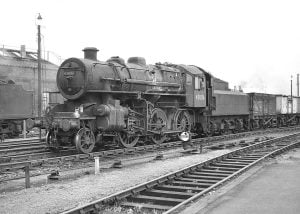On top of our new “Class Information” series, we will also be launching another new series starting today, “Sole Survivor”. As the name suggests, the series will focus on classes where only one member has survived into preservation. This week, we have decided to start with the London Midland and Scottish Railway (LMS) Ivatt Class 4, after a request to cover the class by one of our followers. Once covering the history of the Ivatt Class 4, we will then look at the preservation history of the last class member, No.43106.
History of LMS Ivatt Class 4
Following the sudden death of Fairburn, who was Chief Mechanical Engineer (CME) of the LMS, Ivatt was chosen as his successor on February 1st, 1946.

Most of the locomotive policy under Ivatt's time as CME followed on from Stanier and Fairburn, such as building further Black 5s and 8Fs and also rebuilding the Royal Scots and Patriot classes. On top of this, Ivatt produced a three of his own designs, the biggest being his Class 4 locomotives.
Construction of the class started under LMS ownership in 1947, with the first three engines receiving LMS numbers. These being 3000 to 3002, the rest were only allocated their British Railways' (BR) number (eg 43000). The basic dimensions and features include: 2-6-0 wheel arrangement (coupled wheels – 5 foot (ft) 3 inch (in), leading truck – 3ft), LMS D4 boiler pressed at 225 lbf/in2, two outside cylinders (17 1/2 in diameter and 26 in stroke) worked by Walschaerts valve gearing, 55ft and 11in in length, total weight came in at 99.40 long tons and a tractive effort of 24,170 lbf.
Performance in Service
Majority of the class was allocated to the London Midland Region, former routes owned and operated by the LMS. Here, the Ivatt 4s performed freight and secondary route duties.
The class also ventured onto the East Anglian and Somerset and Dorset Joint Railway. On the former, the class played a prominent role and were numerous, on the latter the class were transferred away soon after being allocated, due to poor steaming on the route.
The cause of the poor steaming was traced back to the double chimneys and blastpipes fitted to the first 50 engines. The uses of a single chimney and blastpipe corrected the poor steaming issue.
The exterior of the class didn't appeal to every enthusiast, with the high running plate and double chimney created an interesting looking engine, similar to American practices.
Despite this, the design was very good on mechanical grounds, being easy to maintain and dispose of due to the time and labour saving features and design. The class would go on to form the bases for the BR Standard 4s, design by Riddles who had previously worked with Ivatt on the LMS.
Decline and Withdrawal
162 engines (75 – Horwich Works, 50 – Doncaster Works and 37 – Darlington Works) were in traffic by 1952, showing the usefulness of and need for the class. This is reflected in the withdrawal of the class, which didn't start until 1963.
Being built in the late 40s / early 50s, the class as a whole weren't very old when they were withdrawn and scrapped. The last members of the class survived until the last year of steam, 1968.
Preservation
Fortunately, one member of the class has survived into preservation, this being No.43106, which also turned out to be the last member in service.
Although suffering minor damage in Spring 1968, the Ivatt Class 4 Group carried out necessary repairs and the engine arrived at its new home on the Severn Valley Railway (SVR) on August 2nd, 1968. This makes 43106 one of the line's first engines.
From the start, 43106 took part in a number of special events both on the SVR and other heritage centres, such as the SVR's official opening day in May 1970 and Rail 150 celebrations at Shildon.
The Ivatt 4 has also hauled several tours on the mainline in the 70s and 80s, such as the “Flying Pig” (One of 43106's nicknames) on April 11th, 1981 from Didcot to Knowle and return.
Since then, 43106 has clocked up many miles hauling normal passenger trains down the SVR, also attending many galas both home and away.
Current boiler ticket expires in 2023 following boiler work allowing the issue of a new boiler ticket in July 2013. BR Lined Black with Late Crest is currently carried by the engine.
For more information about 43106, please the Severn Valley Railway's website here
We hope you enjoyed the first of our new Sole Survivor series. The next instalment will be published two weeks from now (Friday 1st of June), with next Friday seeing the next “Class Information being released.
- Visit the RailAdvent news homepage
For the latest railway news - Visit the RailAdvent Shop
For railway related goodies! - Visit LocoStop – Our New Social Network
Come and share your photo's and video's, join the discussion.
Find out what others are sharing
Let’s get mallard back on the main line in BR BRUNSWICK GREEN…..
Yes I understand what you say. About Mallard the world’s most famous steam train it should not be stuck in a museum dead. Money should be spent on overhaul in our heritage of our contribution to industrial past not building new steam trains. Look a sign of our times. You just don’t change names of trains every few years iv herd Tornado is having a new name. What a joke I spent all my youth walking round steam sheds. Holbeck nevell Hill Farnley copply Hill crabbing all the lined up trains in smokey sheds and crabbing all the trains that pulled in to the stations steams in my blood thank you.
If only Lode Star could be overhauled and returned to service. It’s just a pipe dream,but.